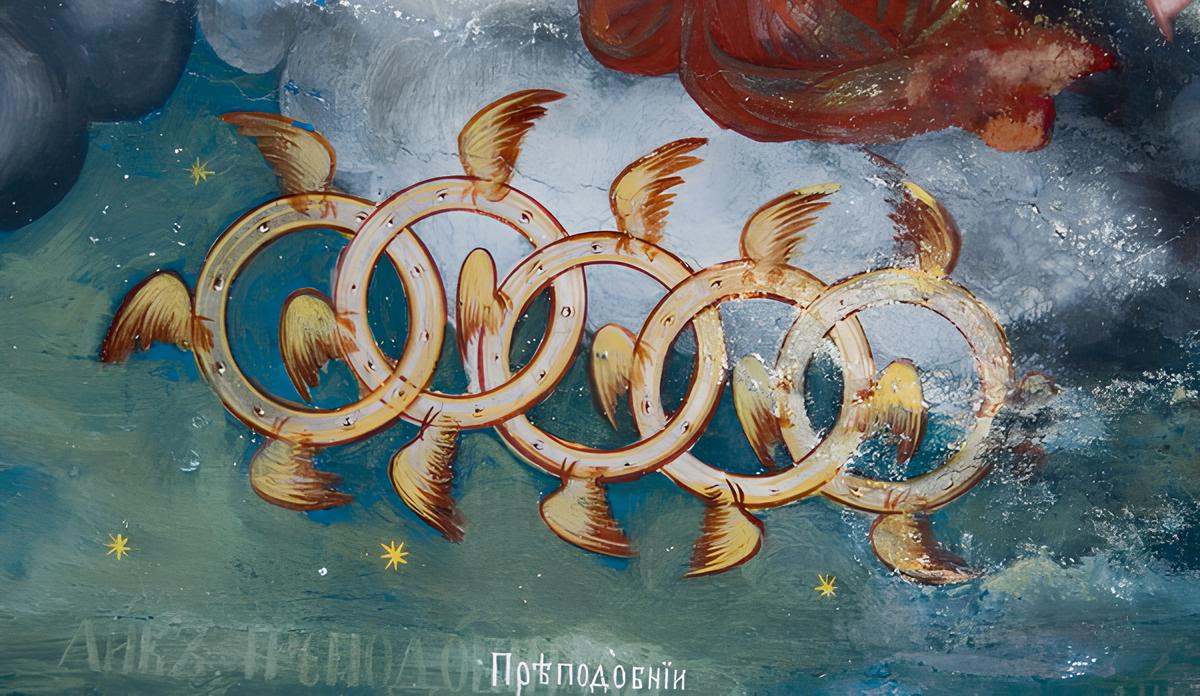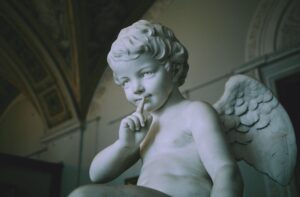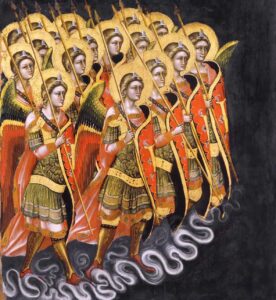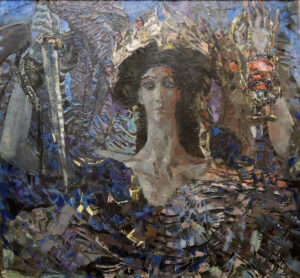Featured image: Ezekiel’s Wheel in St. John the Baptist Church in Kratovo, Macedonia. Public domain, via Wikimedia Commons
Key Takeaways
- Symbol of Justice and Stability: The Thrones represent cosmic justice and unwavering stability within Christian mythology.
- Unique Imagery: Their form as wheels covered in eyes signifies omniscience, vigilance, and interconnectedness.
- Role in the Angelic Hierarchy: Positioned in the highest angelic sphere, the Thrones act as conduits of wisdom and order.
- Cross-Cultural Resonance: Similar symbols appear in other traditions, reflecting universal themes of cyclic order and cosmic balance.
- Modern Relevance: The Thrones inspire values of humility, justice, and self-awareness, which remain meaningful across times and cultures.
In Christian angelology, few figures are as enigmatic as the Thrones, also known as the Ophanim or “wheel-like” angels. Unlike the more familiar Seraphim or Cherubim, these celestial beings are depicted as wheels covered in eyes, moving with seamless precision and harmony. The Thrones hold a unique and high-ranking position within the angelic hierarchy, closest to the divine presence, where they serve as instruments of cosmic order, divine justice, and omniscience. Their portrayal as complex and powerful symbols sets them apart as both guardians and conveyors of divine wisdom.
In Christian mythology, the Thrones occupy the highest triad of the angelic hierarchy, alongside the Seraphim and Cherubim. This proximity to the divine source signifies their role as intermediaries, standing as representations of divine justice and authority. The Thrones not only support the throne of God but also transmit divine insight and judgment to the lower orders of angels. Their purpose within the celestial realm is to help maintain cosmic balance and order, ensuring the alignment of creation with divine will.
Table of Contents
Origins and Appearance of Thrones
The Thrones, or Ophanim, are recognized for their unusual and symbolic imagery, setting them apart from other angelic figures. While many angels are depicted as human-like or with wings, the Thrones are consistently represented as wheels filled with eyes, underscoring their unique role as celestial stabilizers and conduits of divine knowledge.
Biblical References
The most detailed description of the Thrones appears in the prophet Ezekiel’s vision in the Hebrew Bible. In Ezekiel 1:15-21, the Thrones are described as “wheels within wheels,” each covered with countless eyes along their rims. These wheels move in tandem with living creatures—later identified as Cherubim—and can travel in any direction without turning. This powerful image of multi-directional movement and numerous eyes suggests that the Thrones possess a form of omniscience and omnipresence, implying that they are ever-watchful and fully aware of all that occurs in creation.
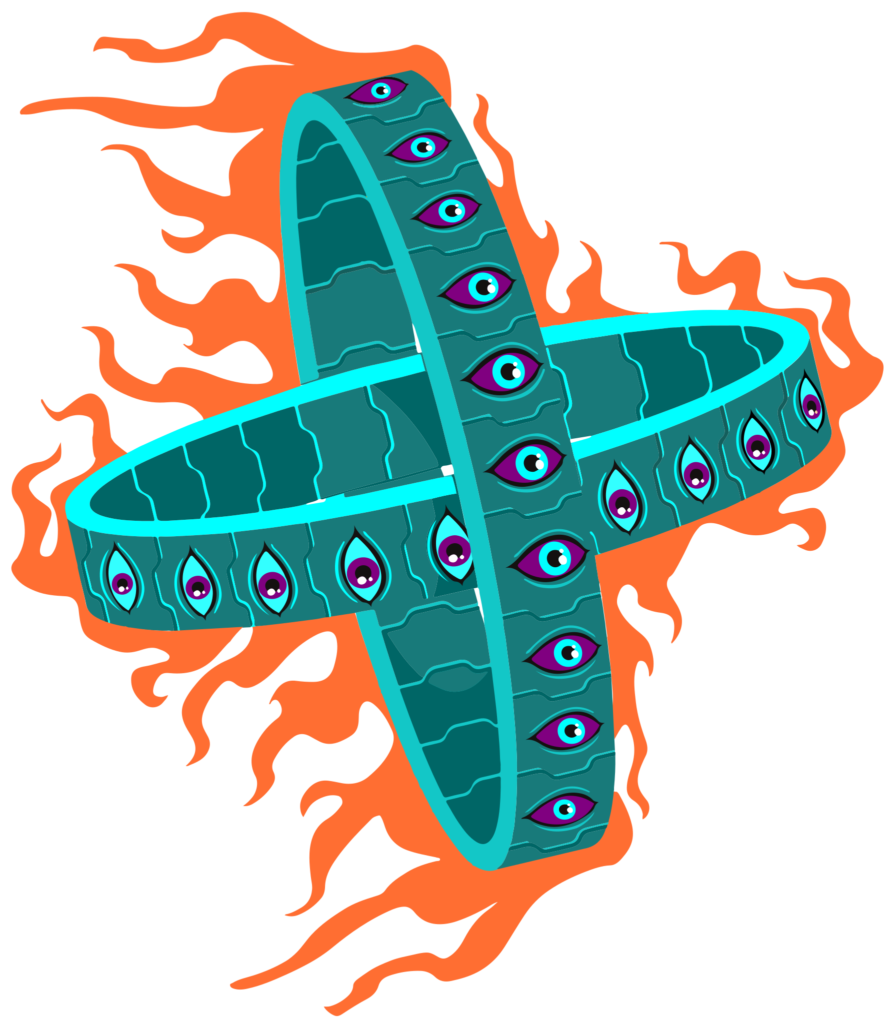
Their rims were high and awesome, and all four rims were full of eyes all around… When the creatures moved, the wheels moved; when the creatures stood still, the wheels stood still.
— Ezekiel 1:18-19
Image: A modern representation of an Ophanim. Paladium, CC BY-SA 4.0, via Wikimedia Commons.
This passage underscores the Thrones’ close connection to the Cherubim and their alignment with divine will, symbolizing their role in maintaining cosmic harmony. Ezekiel’s description offers a radiant and awe-inspiring portrayal of the Thrones as guardians within the heavenly hierarchy, deeply intertwined with the vision of divine justice.
In Daniel 7:9, another prophetic vision mentions the Thrones, describing the throne of God as having “wheels of burning fire.” Here, the wheels are associated with fire—a frequent biblical symbol for divine power, purity, and judgment. This fiery nature emphasizes the Thrones’ role in divine justice, representing an active and purifying force in the cosmos, embodying the dynamic presence of divine authority.
As I looked, thrones were placed, and the Ancient of Days took his seat… his throne was fiery flames, its wheels were burning fire.
— Daniel 7:9
Apocryphal and Mystical Sources
Beyond the canonical Bible, references to the Thrones also appear in apocryphal and mystical writings. 2 Enoch, an apocryphal Jewish text, describes a vision of “many-eyed ones” positioned near the throne of God, often identified as the Thrones. They are depicted alongside other high-ranking celestial beings like Cherubim and Seraphim, reinforcing their association with divine omniscience and vigilance.
The early Christian theologian Pseudo-Dionysius the Areopagite further developed the angelic hierarchy, placing the Thrones in the highest triad alongside the Seraphim and Cherubim in his seminal work, The Celestial Hierarchy. According to Pseudo-Dionysius, the Thrones are uniquely receptive to divine knowledge, which they transmit to lower orders of angels. Their role as mediators between the divine source and other celestial beings emphasizes their position as “heavenly counselors,” acting as channels for divine insight and judgment.
Symbolism of Eyes and Wheels
The defining features of the Thrones—the eyes and wheels—carry deep symbolic meanings. The countless eyes covering their rims symbolize divine omniscience, signifying the all-seeing awareness attributed to the divine. In this sense, the Thrones represent an ability to witness and understand every action and intention within creation, embodying a form of cosmic vigilance. Their unblinking gaze symbolizes oversight and accountability, suggesting that every element of the universe is subject to divine understanding.
The “wheels within wheels” imagery implies an aspect of eternal motion, symbolizing the timeless and interconnected nature of divine existence. Wheels, in many ancient cultures, were associated with the heavens and celestial bodies, representing cyclical movement and the concept of eternity. The circular form of the Thrones reflects an unending cycle, embodying the perpetual movement of divine energy that sustains creation.
Role and Function of Thrones in the Celestial Hierarchy
As beings in the highest ranks of the celestial hierarchy, the Thrones serve as a unique link between the divine source and the rest of creation. Their placement alongside the Seraphim and Cherubim highlights their importance in conveying divine justice and stability. They serve as channels through which divine order flows to the lower angelic spheres, enabling them to maintain cosmic harmony and ensure that divine will is upheld throughout creation.
Thrones as Guardians and Supporters of Divine Justice
A primary function of the Thrones is their role in cosmic justice. The Thrones are intermediaries, bridging the divine source with lower angelic orders, transmitting divine justice to sustain universal order. They act as impartial observers who maintain the balance of creation, ensuring that all beings are aligned with the divine will.
The Thrones’ association with wheels captures the paradox of divine justice: it is constant and stable, yet dynamically active throughout the cosmos. By observing every action and thought within creation, the Thrones embody the impartial and all-seeing judgment of the divine. Early Christian writers viewed them as “living symbols” of God’s authority, stabilizing the divine hierarchy by serving as vessels for divine judgment.
Interaction with Other Angels
The Thrones’ role extends to interactions with other angelic orders. They receive divine illumination directly and impart this wisdom to the second triad of angels, which includes the Dominions, Virtues, and Powers. These intermediary angels, in turn, transmit divine commands to the lower orders—Principalities, Archangels, and Angels—who interact more directly with the physical and spiritual realms.
Their close relationship with the Cherubim, as illustrated in Ezekiel’s vision, demonstrates a harmony between divine wisdom and justice. The Cherubim bring understanding, while the Thrones uphold justice and stability. Together, they create a balanced and unified order within the angelic hierarchy, each fulfilling a distinct yet interconnected role in sustaining divine harmony.

Symbolism and Cultural Interpretations of Thrones
The Thrones, with their extraordinary form, serve as potent symbols of divine justice, interconnectedness, and eternal vigilance. Their depiction as wheels filled with eyes suggests meanings that transcend their celestial role. This section examines their symbolic interpretations, comparisons to other mythologies, and their expression of universal themes.
The Wheels-Within-Wheels Imagery
The Thrones’ wheels-within-wheels represent a complex symbol of omnipresence and interconnectedness, as the Thrones are capable of moving in all directions simultaneously. The Thrones’ ability to move freely without turning implies that divine action is unbounded, encompassing all directions and reaching all realms. This symbolism resonates with the concept of divine omnipresence, an idea that suggests a guiding, unseen hand shaping existence.
The Thrones’ cyclical form reflects the recurring processes of creation, destruction, and rebirth. This wheel imagery appears in various traditions and often symbolizes eternity, a constant flow and the unbroken continuity of the divine.
The Significance of Fire and Eyes in Ancient Symbolism
In Daniel 7:9, the Thrones are associated with “wheels of burning fire,” symbolizing purity, power, and transformation. Fire is a frequent symbol for divine energy and purification across religions, and in this context, it represents the Thrones’ role as channels of divine power. Fire purifies and transforms, aligning with the Thrones’ function as carriers of divine justice, which purges and renews.
The eyes on the Thrones reflect vigilance and wisdom, emphasizing their role as watchful guardians. In many ancient cultures, eyes symbolize insight, vigilance, and awareness. The Thrones’ many eyes suggest they are all-seeing and impartial, ensuring every action in the cosmos is observed. This comprehensive vision underscores the idea of accountability, with every aspect of creation open to scrutiny.
Comparisons in Other Cultural Myths and Symbolic Systems
The Thrones’ symbolism resonates with imagery found in other cultural traditions, highlighting a universal appeal. The Hindu Dharma Wheel, symbolizing the cycle of life and cosmic law, parallels the Thrones’ wheel-like form. Like the Thrones, the Dharma Wheel signifies interconnectedness and the endless cycle of creation, order, and renewal.
In Hindu and Buddhist traditions, deities with multiple eyes, like Shiva and Indra, represent heightened awareness and cosmic perception, reflecting the Thrones’ role as all-seeing beings. The symbolic association with fire also connects to Zoroastrianism, where fire represents truth and purity, aligning with the Thrones’ role as agents of divine justice.

Theological and Mystical Significance
The Thrones’ unique characteristics have inspired theological and mystical interpretations that emphasize their role as symbols of wisdom, stability, and cosmic justice. From early Christian theology to modern esoteric literature, these interpretations offer varied perspectives on the Thrones’ significance.
Interpretation in Christian Mysticism and Theology
Pseudo-Dionysius described the Thrones as highly receptive beings who transmit divine insights to lower orders. Christian mystics, including Thomas Aquinas, viewed the Thrones as contemplative beings who embody humility, reflecting divine authority without personal ambition. Their receptivity and impartiality make them models of divine wisdom, underscoring themes of justice and humility.
Esoteric and Modern Interpretations
In modern esoteric traditions, the Thrones are sometimes seen as guardians of cosmic stability. Their “wheel within a wheel” imagery symbolizes interconnectedness and cyclical order. Rosicrucian and mystical traditions emphasize the Thrones’ role as stabilizers who maintain harmony. Some modern interpretations also see the Thrones as symbols for self-reflection and balance, encouraging spiritual seekers to cultivate awareness and justice.
Reflections on Divine Justice and Cosmic Order
The Thrones’ roles as bearers of divine justice and cosmic order suggest that all actions are observed, resonating with concepts of universal law. This impartial justice reassures those who believe in a moral order governing existence. For theologians and mystics, the Thrones embody cosmic stability and justice that is beyond human understanding but ever-present.
Conclusion
The Thrones, as symbolic figures within Christian mythology, represent ideals of justice, wisdom, and stability that resonate across cultures and time periods. Their depiction as wheel-like beings covered in eyes conveys themes of vigilance, interconnectedness, and balanced motion, ideas that reflect humanity’s ongoing search for harmony and ethical awareness. Through studying these symbols, we gain insights into the value of maintaining perspective, practicing humility, and recognizing the interconnected nature of our actions and choices.
Ultimately, the Thrones encourage a reflection on values that are universally relevant, inspiring us to seek justice, cultivate awareness, and contribute to balance within our communities and the world.

